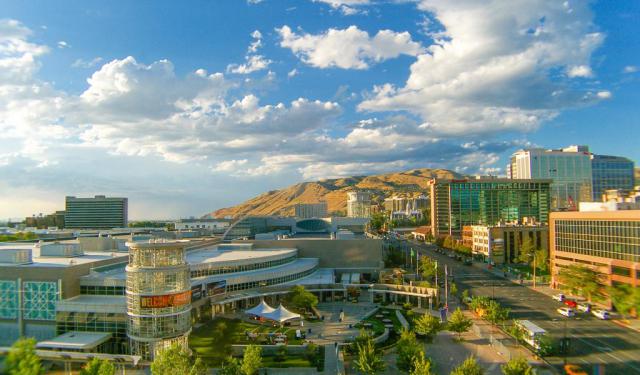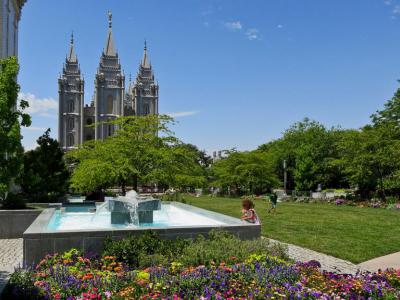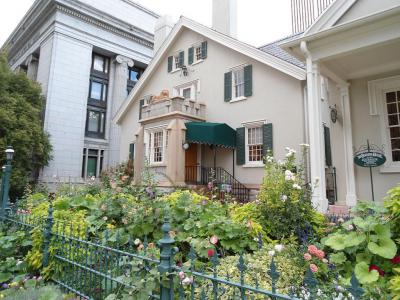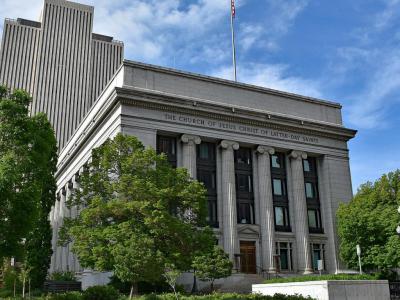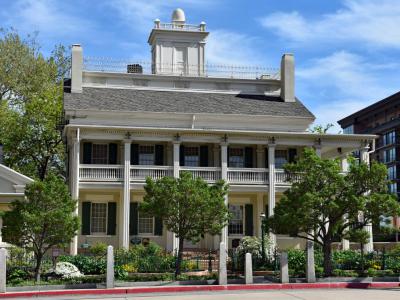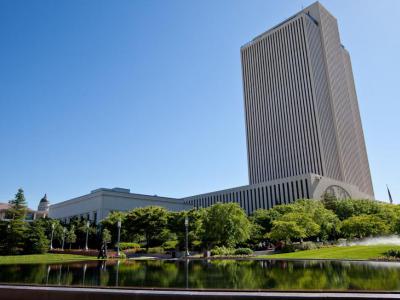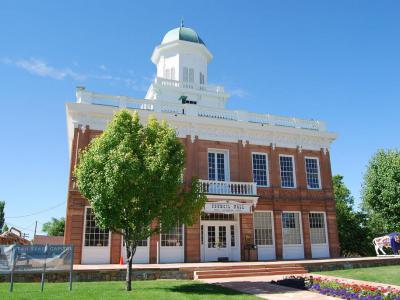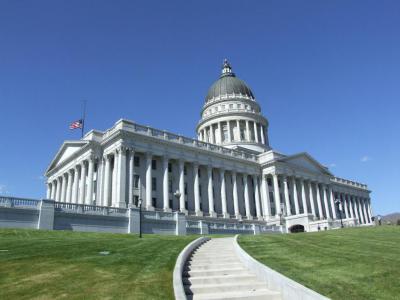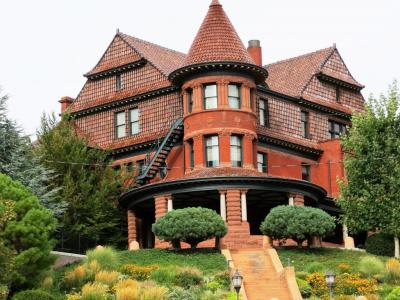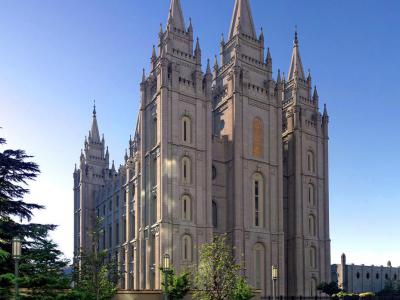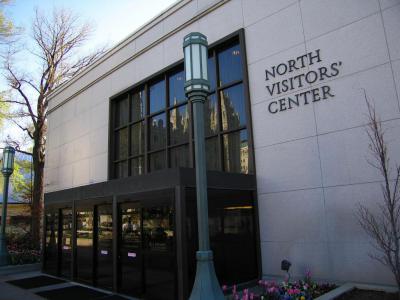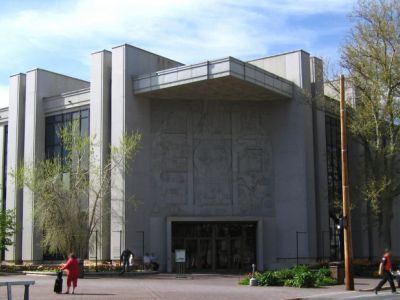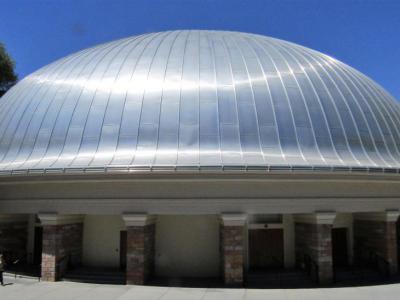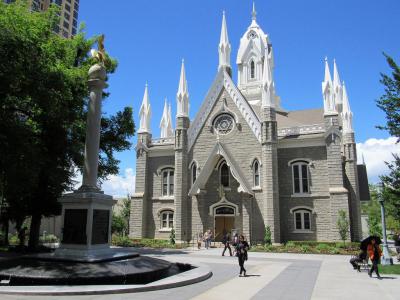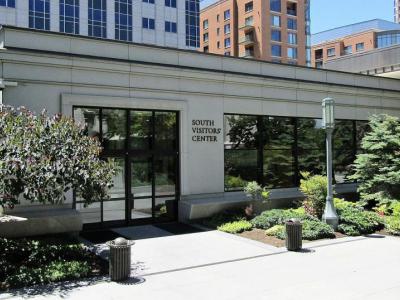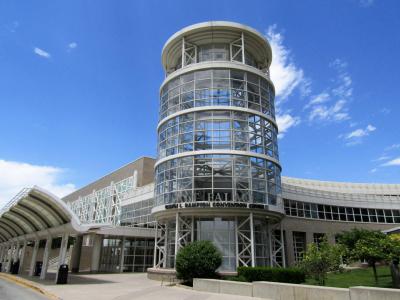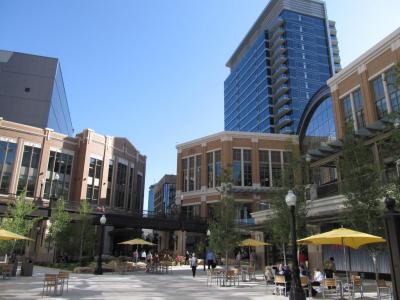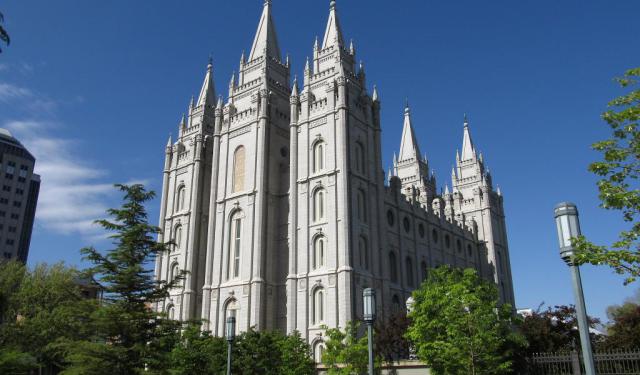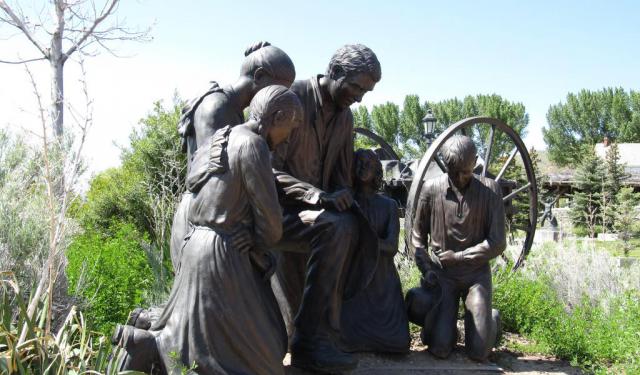Salt Lake City Downtown Walk (Self Guided), Salt Lake City
Salt Lake City's downtown epitomizes the city's settlement and growth. Renowned for its cleanliness, visitors often praise its meticulously planned layout, reminiscent of a Cartesian graph centered around Temple Square, a sacred site for members of The Church of Jesus Christ of Latter-day Saints (LDS).
In 1847, Brigham Young, leader of Mormon pioneer settlers, designated the site for the Salt Lake Temple, where subsequent development established the physical nucleus of the LDS Church. Presently, this majestic temple is an architectural marvel that draws members of the LDS faith from around the world.
Nearby, the Joseph Smith Memorial Building, formerly a hotel, stands tall boasting impressive Second Renaissance Revival architecture. Today, this is a public venue and museum, with the top-floor Garden Restaurant providing a unique dining experience complete with stunning views of Temple Square and downtown Salt Lake City.
The Lion House and Beehive House offer glimpses into Utah's pioneer past, while the Church Administration and Church Office Buildings symbolize the administrative center of the LDS Church.
As you wander through downtown, you'll come across other significant landmarks such as Council Hall, once the seat of government for the territory of Utah, and the State Capitol, a magnificent structure overlooking the city. History buffs will appreciate visits to the McCune Mansion, Salt Lake Tabernacle, and Salt Lake Assembly Hall, each telling a unique story of the city's development.
For those interested in learning more about the Mormon faith and its history, the North Visitors' Center, Church History Museum, and South Visitors' Center provide immersive experiences and educational insights. Meanwhile, the Salt Palace Convention Center and City Creek Center offer modern amenities and shopping opportunities for visitors and locals alike.
Whether you're drawn to the spiritual significance of Temple Square or the architectural wonders scattered throughout downtown, Salt Lake City offers ample opportunities to satisfy both. Come explore the vibrant streets, soak in the history, and create lasting memories in this dynamic urban center.
In 1847, Brigham Young, leader of Mormon pioneer settlers, designated the site for the Salt Lake Temple, where subsequent development established the physical nucleus of the LDS Church. Presently, this majestic temple is an architectural marvel that draws members of the LDS faith from around the world.
Nearby, the Joseph Smith Memorial Building, formerly a hotel, stands tall boasting impressive Second Renaissance Revival architecture. Today, this is a public venue and museum, with the top-floor Garden Restaurant providing a unique dining experience complete with stunning views of Temple Square and downtown Salt Lake City.
The Lion House and Beehive House offer glimpses into Utah's pioneer past, while the Church Administration and Church Office Buildings symbolize the administrative center of the LDS Church.
As you wander through downtown, you'll come across other significant landmarks such as Council Hall, once the seat of government for the territory of Utah, and the State Capitol, a magnificent structure overlooking the city. History buffs will appreciate visits to the McCune Mansion, Salt Lake Tabernacle, and Salt Lake Assembly Hall, each telling a unique story of the city's development.
For those interested in learning more about the Mormon faith and its history, the North Visitors' Center, Church History Museum, and South Visitors' Center provide immersive experiences and educational insights. Meanwhile, the Salt Palace Convention Center and City Creek Center offer modern amenities and shopping opportunities for visitors and locals alike.
Whether you're drawn to the spiritual significance of Temple Square or the architectural wonders scattered throughout downtown, Salt Lake City offers ample opportunities to satisfy both. Come explore the vibrant streets, soak in the history, and create lasting memories in this dynamic urban center.
How it works: Download the app "GPSmyCity: Walks in 1K+ Cities" from Apple App Store or Google Play Store to your mobile phone or tablet. The app turns your mobile device into a personal tour guide and its built-in GPS navigation functions guide you from one tour stop to next. The app works offline, so no data plan is needed when traveling abroad.
Salt Lake City Downtown Walk Map
Guide Name: Salt Lake City Downtown Walk
Guide Location: USA » Salt Lake City (See other walking tours in Salt Lake City)
Guide Type: Self-guided Walking Tour (Sightseeing)
# of Attractions: 17
Tour Duration: 2 Hour(s)
Travel Distance: 3.1 Km or 1.9 Miles
Author: tamara
Sight(s) Featured in This Guide:
Guide Location: USA » Salt Lake City (See other walking tours in Salt Lake City)
Guide Type: Self-guided Walking Tour (Sightseeing)
# of Attractions: 17
Tour Duration: 2 Hour(s)
Travel Distance: 3.1 Km or 1.9 Miles
Author: tamara
Sight(s) Featured in This Guide:
- Temple Square
- Joseph Smith Memorial Building
- Lion House
- Church Administration Building
- Beehive House
- Church Office Building
- Council Hall
- State Capitol
- McCune Mansion
- Salt Lake Temple
- North Visitors' Center
- Church History Museum
- Salt Lake Tabernacle
- Salt Lake Assembly Hall
- South Visitors' Center
- Salt Palace
- City Creek Center
1) Temple Square (must see)
In 1847, when Mormon pioneers arrived in the Salt Lake Valley, president Brigham Young selected a plot of the desert ground and proclaimed, "Here we will build a temple to our God." When the city was surveyed, the block enclosing that location became known as Temple Square and a 15-foot surrounding wall was built shortly after the block was so designated. Now attracting 3 million to 5 million visitors a year, Temple Square is the most popular tourist attraction in Utah, bringing in more visitors than the Grand Canyon or Yellowstone National Park.
Though the 10-acre (4.0 hectares) complex is mostly known as the headquarters of the LDS Church, other buildings currently contained within are the Salt Lake Tabernacle, the Salt Lake Assembly Hall, the Seagull Monument, and two visitors' centers, the one on the north being the larger of the two. Most of the buildings are open and you are free to walk in and look around, enjoy the well-tended grounds, sneak in a picture by the reflecting pool, or have dinner/coffee in the coffee shop or restaurant on site. Let's not forget the many statues and flower beds for everyone to enjoy!
The grounds, as well as the Gardens at Temple Square, often host concerts and other events. During the Christmas holiday season, approximately 100,000 Christmas lights sparkle from trees and shrubs around Temple Square each evening until 10 pm. The lighting of Temple Square is a popular event, usually attended by more than 10,000 people.
Though the 10-acre (4.0 hectares) complex is mostly known as the headquarters of the LDS Church, other buildings currently contained within are the Salt Lake Tabernacle, the Salt Lake Assembly Hall, the Seagull Monument, and two visitors' centers, the one on the north being the larger of the two. Most of the buildings are open and you are free to walk in and look around, enjoy the well-tended grounds, sneak in a picture by the reflecting pool, or have dinner/coffee in the coffee shop or restaurant on site. Let's not forget the many statues and flower beds for everyone to enjoy!
The grounds, as well as the Gardens at Temple Square, often host concerts and other events. During the Christmas holiday season, approximately 100,000 Christmas lights sparkle from trees and shrubs around Temple Square each evening until 10 pm. The lighting of Temple Square is a popular event, usually attended by more than 10,000 people.
2) Joseph Smith Memorial Building (must see)
Formerly known as the Hotel Utah, the Joseph Smith Memorial Building is meant to impress and, in all candor, is very impressive indeed. Constructed between 1909-11, it was the "Grand Dame" of hotels in the Intermountain West for most of the 20th century, with the LDS Church as its chief stockholder. Topped by a huge cupola shaped as a beehive (Utah's state symbol), this lavish example of Second Renaissance Revival architecture stands out both for the elegant exterior design, as well as for the noble, high-class, epicurean interior décor and amenities.
John F. Kennedy, Jimmy Stewart, Katharine Hepburn, Henry Fonda, Liberace, Warren Burger, John Glenn and Ella Fitzgerald all slept and dined here in their sojourn. Today, the building is a public venue and lounge, as well as an "active museum" of sorts. Make it a point to go to the top floor, where you will be treated to sublime, uninterrupted views of the Temple Square and the expansive downtown Salt Lake City core. When properly planning your itinerary, you may additionally elect to dine at the top-floor Garden Restaurant, which is guaranteed to render the experience truly unique and special.
John F. Kennedy, Jimmy Stewart, Katharine Hepburn, Henry Fonda, Liberace, Warren Burger, John Glenn and Ella Fitzgerald all slept and dined here in their sojourn. Today, the building is a public venue and lounge, as well as an "active museum" of sorts. Make it a point to go to the top floor, where you will be treated to sublime, uninterrupted views of the Temple Square and the expansive downtown Salt Lake City core. When properly planning your itinerary, you may additionally elect to dine at the top-floor Garden Restaurant, which is guaranteed to render the experience truly unique and special.
3) Lion House
Taking its name from the recumbent lion set on top of the front portico, this house was constructed 1855-56 as a residence for some of Mormon leader Brigham Young's wives and children. Like all other buildings on Temple Square, it has been pristinely preserved, looking like it was built last year. There is now a pleasant cafeteria-style restaurant inside serving local fare to the faithful and the visitors alike. When you see people gathering together to enter, you know you're in for a good lunch – and you likely won't be disappointed. The homemade bread rolls served with honey butter are Utah famous!
Back in the day, the basement contained a dining room which could accommodate 70 people, while on the main floor were sitting rooms and bedrooms for wives with children. The 2nd floor contained 20 bedrooms for children and childless wives – one under each of the steeply-pitched gables. A polygamist, Young ultimately fathered 57 children by more than two dozen wives, and also had many adopted, foster, and stepchildren. By the 1930s, however, the practice of polygamy had been abandoned by the LDS Church and banned by the state of Utah, making it punishable by imprisonment and a hefty fine.
Back in the day, the basement contained a dining room which could accommodate 70 people, while on the main floor were sitting rooms and bedrooms for wives with children. The 2nd floor contained 20 bedrooms for children and childless wives – one under each of the steeply-pitched gables. A polygamist, Young ultimately fathered 57 children by more than two dozen wives, and also had many adopted, foster, and stepchildren. By the 1930s, however, the practice of polygamy had been abandoned by the LDS Church and banned by the state of Utah, making it punishable by imprisonment and a hefty fine.
4) Church Administration Building
Adjacent to Temple Square, the LDS Church constructed this building between 1914-17 to serve as its headquarters. Prior to its completion, the office of the church president was located just to the east between the Lion and Beehive houses. Today this structure continues to house the offices of the LDS First Presidency and other church leaders.
An excellent example of Neoclassical style architecture, the building features 24 Ionic pilasters that are made of solid granite and weigh approximately 8 tons each. This granite, as well as that which covers the rest of the steel and concrete structure, was taken from the same quarry as the stone used to build the Salt Lake Temple.
The building's architects, Joseph Don Carlos Young and Don Carlos Young, were the son and grandson, respectively, of Brigham Young, the nineteenth-century Mormon leader who brought his flock to Utah.
An excellent example of Neoclassical style architecture, the building features 24 Ionic pilasters that are made of solid granite and weigh approximately 8 tons each. This granite, as well as that which covers the rest of the steel and concrete structure, was taken from the same quarry as the stone used to build the Salt Lake Temple.
The building's architects, Joseph Don Carlos Young and Don Carlos Young, were the son and grandson, respectively, of Brigham Young, the nineteenth-century Mormon leader who brought his flock to Utah.
5) Beehive House
Getting its name from the clearly visible beehive sculpture on top, this was one of two official residences of Brigham Young, who led the famous Mormon migration from Nauvoo, IL, to the Salt Lake Valley in 1847 and became the 2nd president (after founder Joseph Smith) of The Church of Jesus Christ of Latter-Day Saints. Like most buildings on Temple Square, the house is meticulously maintained and can be visited on a free 30-minute tour that takes you around the lower and 2nd floor. Featuring superb woodwork and craftsmanship throughout, the tour provides an excellent opportunity to dig into local history – so if you love old houses and learning about how people lived in times past, this is for you!
Constructed of adobe and sandstone, the home was designed by Young's brother-in-law and architect of the Salt Lake Temple, Truman O. Angell, who also designed the neighboring Lion House – once a home many of his wives and children. Although perhaps an over-achiever in "raising up seed", Young was nonetheless devoted to his first wife above all, as anyone who visits both the Beehive House and the Lion House can attest.
Constructed of adobe and sandstone, the home was designed by Young's brother-in-law and architect of the Salt Lake Temple, Truman O. Angell, who also designed the neighboring Lion House – once a home many of his wives and children. Although perhaps an over-achiever in "raising up seed", Young was nonetheless devoted to his first wife above all, as anyone who visits both the Beehive House and the Lion House can attest.
6) Church Office Building
As membership of the LDS Church has expanded and multiplied on a worldwide basis in the 20th century, its administrative departments and agencies have so grown in size and in number that, at one point, Church offices were spread all over Salt Lake City. That picture has changed somewhat in 1972 with completion of this 28-story office building, which gathered various departments under one roof and became the state's tallest structure from 1973 until 1998.
A 360-degree observation deck is open to the public for free, and provides a good view of Antelope Island and the Great Salt Lake to the northwest, the Wasatch Mountains to the north and east, the skyline of the city to the south, the Oquirrh Mountains to the west, and Temple Square to the immediate west. Visitors can also take a free tour of the surrounding gardens, which are completely redesigned every six months, and feature an array of exotic plants and flowers.
On the tower itself, the facades all feature a closely spaced vertical pinstripe pattern of cast quartzite columns flanking the narrow windows, visually reminiscent of New York City's former World Trade Center. Take special note of the gigantic precast stone maps of the world, standing out in bold relief on both north and south sides of each wing, proclaimig a worldwide church. The lobby is dominated by a massive mural depicting the Great Commission, in addition to the statue honoring Mormon pioneer sacrifices, which depicts a husband and wife burying an infant child. The inscription reads, "That the struggles, sacrifices and the sufferings of the faithful pioneers and the cause they represented shall never be forgotten."
A 360-degree observation deck is open to the public for free, and provides a good view of Antelope Island and the Great Salt Lake to the northwest, the Wasatch Mountains to the north and east, the skyline of the city to the south, the Oquirrh Mountains to the west, and Temple Square to the immediate west. Visitors can also take a free tour of the surrounding gardens, which are completely redesigned every six months, and feature an array of exotic plants and flowers.
On the tower itself, the facades all feature a closely spaced vertical pinstripe pattern of cast quartzite columns flanking the narrow windows, visually reminiscent of New York City's former World Trade Center. Take special note of the gigantic precast stone maps of the world, standing out in bold relief on both north and south sides of each wing, proclaimig a worldwide church. The lobby is dominated by a massive mural depicting the Great Commission, in addition to the statue honoring Mormon pioneer sacrifices, which depicts a husband and wife burying an infant child. The inscription reads, "That the struggles, sacrifices and the sufferings of the faithful pioneers and the cause they represented shall never be forgotten."
7) Council Hall
The Salt Lake City Council Hall, perched on Capitol Hill in Salt Lake City, is a remarkable historical site that now houses the offices of the Utah Office of Tourism and the Utah Film Commission. Originally known as the Old Salt Lake City Hall, this structure served as the city hall from 1866 to 1894, a period marked by intense political and social shifts as the Utah Territory clashed with federal authorities. In 1975, it was designated a National Historic Landmark due to its historical significance.
Built between 1864 and 1866 under the architectural guidance of William H. Folsom, a key figure in the design work for the LDS Church, the hall was constructed of sandstone sourced from Red Butte Canyon. This Greek Revival building was meant to replace a smaller city hall that quickly became insufficient for Salt Lake City's growing population after the Utah War.
Council Hall, dedicated in January 1866 with leaders like Brigham Young present, became the city’s government center for nearly 30 years. It housed the mayor's office and departments on the first floor, while the second-floor Rose Room served as a courtroom and legislative space. In August 1874, Mayor Daniel H. Wells declared martial law from the balcony amid tensions with federal marshals at a congressional election.
After the city government relocated in 1894, the building functioned as the police headquarters until 1915 and later took on minor civic roles. In a dramatic turn, to avoid demolition for a federal office project, the hall was dismantled into 325 sandstone slabs in 1961 and reassembled on Capitol Hill. Funded largely by the LDS Church and under architect Edward O. Anderson’s direction, the restoration completed in 1962 breathed new life into this historic building. Today, renamed Council Hall, it stands as a preserved piece of Utah’s storied past.
Built between 1864 and 1866 under the architectural guidance of William H. Folsom, a key figure in the design work for the LDS Church, the hall was constructed of sandstone sourced from Red Butte Canyon. This Greek Revival building was meant to replace a smaller city hall that quickly became insufficient for Salt Lake City's growing population after the Utah War.
Council Hall, dedicated in January 1866 with leaders like Brigham Young present, became the city’s government center for nearly 30 years. It housed the mayor's office and departments on the first floor, while the second-floor Rose Room served as a courtroom and legislative space. In August 1874, Mayor Daniel H. Wells declared martial law from the balcony amid tensions with federal marshals at a congressional election.
After the city government relocated in 1894, the building functioned as the police headquarters until 1915 and later took on minor civic roles. In a dramatic turn, to avoid demolition for a federal office project, the hall was dismantled into 325 sandstone slabs in 1961 and reassembled on Capitol Hill. Funded largely by the LDS Church and under architect Edward O. Anderson’s direction, the restoration completed in 1962 breathed new life into this historic building. Today, renamed Council Hall, it stands as a preserved piece of Utah’s storied past.
8) State Capitol (must see)
Utah's spectacular State Capitol building is a bit of an uphill hike from the heart of downtown Salt Lake City, but well worth the effort. Take in the breathtaking mountain views from the front steps, then head inside to see the state's history unspool through the glorious artwork adorning the walls and ceiling of the cavernous atrium. Traditional architecture built with a variety of stone and other materials, as well as a very open interior, makes this building quite an experience to visit.
Utah history is dramatized in large murals and canvasses, while the dome ceiling is painted with seagulls – the official state bird since 1955. Exhibits from all 29 counties are displayed on the ground floor, but the 2nd floor – and especially the Gold Room where visiting celebrities are hosted – should not be missed. Decorated with native bird's eye marble, the room boasts exquisite chandeliers, chairs and a table adorned with gold leaf from Utah mines.
Once the (free) tour is over, you can ponder your thoughts in the quaint outdoor courtyard area or the really neat park on the east side – just walk along one of the trails to get down the hill. Immediately across the street, the visitor center has lots of free brochures, maps, and travel guides for all of Utah, as well lots of awesome and affordable gifts and collectibles.
Utah history is dramatized in large murals and canvasses, while the dome ceiling is painted with seagulls – the official state bird since 1955. Exhibits from all 29 counties are displayed on the ground floor, but the 2nd floor – and especially the Gold Room where visiting celebrities are hosted – should not be missed. Decorated with native bird's eye marble, the room boasts exquisite chandeliers, chairs and a table adorned with gold leaf from Utah mines.
Once the (free) tour is over, you can ponder your thoughts in the quaint outdoor courtyard area or the really neat park on the east side – just walk along one of the trails to get down the hill. Immediately across the street, the visitor center has lots of free brochures, maps, and travel guides for all of Utah, as well lots of awesome and affordable gifts and collectibles.
9) McCune Mansion
Situated on a prominent corner location on Capitol Hill, the McCune Mansion majestically overlooks Temple Square and downtown Salt Lake City. According to the sign on site, it was built in 1901 by railroad and mining tycoon Alfred McCune, who spared little expense on design and decoration, having even financed a two-year tour of America and Europe for architect S.C. Dallas to study different designs and techniques. The chosen design was a Gothic revival plan with East Asian influence, replicating a house that the McCunes saw while driving in New York City.
Now listed on the National Register of Historic Places, the extravagant mansion features imported materials from many parts of the world. McCune had mahogany shipped from San Domingo, oak from England, and a rare white-grained mahogany from South Africa. The red roof tiles came from the Netherlands, and an enormous broad mirror wall was transported from Germany in a specially-made railroad car. The walls were adorned with moiré silks, tapestries, and Russian leather, and only the exterior was built of locally-sourced red sandstone – though some details like the lavish fireplaces used more exotic stone like Nubian marble. At its completion, the mansion had cost McCune one million dollars.
Lovingly restored to its original grandeur, the privately-owned building is open to private tours, business events, weddings and other special occasions. Historical tours are provided by Preservation Utah – call ahead to schedule your tour time.
Now listed on the National Register of Historic Places, the extravagant mansion features imported materials from many parts of the world. McCune had mahogany shipped from San Domingo, oak from England, and a rare white-grained mahogany from South Africa. The red roof tiles came from the Netherlands, and an enormous broad mirror wall was transported from Germany in a specially-made railroad car. The walls were adorned with moiré silks, tapestries, and Russian leather, and only the exterior was built of locally-sourced red sandstone – though some details like the lavish fireplaces used more exotic stone like Nubian marble. At its completion, the mansion had cost McCune one million dollars.
Lovingly restored to its original grandeur, the privately-owned building is open to private tours, business events, weddings and other special occasions. Historical tours are provided by Preservation Utah – call ahead to schedule your tour time.
10) Salt Lake Temple (must see)
The centerpiece of Temple Square, this beautiful neo-gothic edifice took 40 years to build at the direction of then Church President, Brigham Young, and has withstood the test of time since being dedicated in 1893. The granite-like quartz monzonite was quarried in Little Cottonwood Canyon, 22 miles south of the site, and was then laboriously hauled by oxen, stone by stone, until the railroad became operational in 1869. Oriented towards Jerusalem and incorporating a host of symbolic designs and decorations, many of which are visible on the exterior, it remains the largest LDS temple by floor area (253,015 square feet / 23,505.9 square meters). Its massive presence is a marvel, considering there was no electricity, no computers, nor any other artificial means used during construction. The stone masonry is so precise, there is not even mortar between the stones! And then to think the pioneers built this huge edifice in the middle of a desert guided by faith is just awesome.
As with all LDS temples, only qualifying members of the LDS faith can enter the building (used primarily for marriages, baptisms for the dead, religious ritual instruction, and meetings of the First Presidency and of the Quorum of the Twelve Apostles), but visitors can walk around the exterior and enter other historic structures nearby. During the winter months the beauties of the world-famous flower beds are replaced by nativity displays and millions of Christmas lights strung through all the trees on Temple Square, making it a hugely popular destination for visitors and locals alike.
***PIONEERS TRAIL***
As noted by the scholars, "Brigham Young was almost sole author of one of the most important chapters in the history of the American West." When the first group of pioneers, led by Young, entered Immigration Canyon overlooking the Salt Lake Valley on July 24, 1847, Young (who had been ill and was bedded in a covered wagon) rose long enough to gaze out over the valley and famously declared "This is the right place. Drive on." Those with him clearly understood that he was talking about his vision of where the Latter-Day Saints were to settle. It should be noted that Church leaders and members alike felt that settling in Utah (near the Rockies) would fulfill Isaiah 2:2 - "And it shall come to pass in the last days, that the mountain of the LORD'S house [temple] shall be established in the top of the mountains, and shall be exalted above the hills; and all nations shall flow unto it."
Perhaps among Young's greatest visible accomplishments was his initiation of the construction of the world famous Salt Lake Temple and Tabernacle on Temple Square, and the incredible construction of a system of miles and miles of irrigation canals that fulfilled the prophecy in Isaiah 35:1 "The wilderness and the solitary place shall be glad for them; and the desert shall rejoice, and blossom as the rose."
Tip:
One of the best (and free!) views of the edifice (and of Temple Square) is from the atrium and inside of The Roof restaurant, located on the top floor of the Joseph Smith Memorial Building, a short walk and elevator ride directly to the east.
As with all LDS temples, only qualifying members of the LDS faith can enter the building (used primarily for marriages, baptisms for the dead, religious ritual instruction, and meetings of the First Presidency and of the Quorum of the Twelve Apostles), but visitors can walk around the exterior and enter other historic structures nearby. During the winter months the beauties of the world-famous flower beds are replaced by nativity displays and millions of Christmas lights strung through all the trees on Temple Square, making it a hugely popular destination for visitors and locals alike.
***PIONEERS TRAIL***
As noted by the scholars, "Brigham Young was almost sole author of one of the most important chapters in the history of the American West." When the first group of pioneers, led by Young, entered Immigration Canyon overlooking the Salt Lake Valley on July 24, 1847, Young (who had been ill and was bedded in a covered wagon) rose long enough to gaze out over the valley and famously declared "This is the right place. Drive on." Those with him clearly understood that he was talking about his vision of where the Latter-Day Saints were to settle. It should be noted that Church leaders and members alike felt that settling in Utah (near the Rockies) would fulfill Isaiah 2:2 - "And it shall come to pass in the last days, that the mountain of the LORD'S house [temple] shall be established in the top of the mountains, and shall be exalted above the hills; and all nations shall flow unto it."
Perhaps among Young's greatest visible accomplishments was his initiation of the construction of the world famous Salt Lake Temple and Tabernacle on Temple Square, and the incredible construction of a system of miles and miles of irrigation canals that fulfilled the prophecy in Isaiah 35:1 "The wilderness and the solitary place shall be glad for them; and the desert shall rejoice, and blossom as the rose."
Tip:
One of the best (and free!) views of the edifice (and of Temple Square) is from the atrium and inside of The Roof restaurant, located on the top floor of the Joseph Smith Memorial Building, a short walk and elevator ride directly to the east.
11) North Visitors' Center
The North Visitors’ Center in Salt Lake City, a notable landmark on Temple Square, has long served as an inviting gateway for visitors. Nestled between the historic Tabernacle and the Conference Center, this center featured a truly awe-inspiring centerpiece: an 11-foot Italian marble statue of Christus, the work of famed Danish sculptor Bertel Thorvaldsen.
Created for The Church of Our Lady in Copenhagen, the Christus replica has been an emblematic presence since its installation in the 1960s. Set against a backdrop of a stunning mural, the statue sat in a domed room on the second floor, with outstretched arms beneath a painted celestial dome - replicating the Northern Hemisphere’s midnight sky as it appeared on April 6, 1830, the day The Church of Jesus Christ of Latter-day Saints was founded.
The North Visitors’ Center also provided engaging exhibits. Visitors could explore a 14-square-foot interactive map of ancient Jerusalem on the ground floor, complete with artwork narrating events from the life of Jesus Christ. On the basement level, displays offered insights into prophetic figures from The Book of Mormon, stretching from 6,000 B.C. to the time of Joseph Smith. The center even provided practical comforts like cool water and exceptionally clean restrooms, creating a restful environment for guests.
Designed by architect Edward Anderson, this visitors’ center opened in 1963, becoming a central spot for art, religious history, and multimedia exhibits related to the Church. With the ongoing renovation of Temple Square beginning in 2020, the Christus statue has been temporarily moved to storage for conservation and will be reinstalled after the renovation. In the meantime, the Conference Center has taken on a larger role as the main visitors’ venue.
Created for The Church of Our Lady in Copenhagen, the Christus replica has been an emblematic presence since its installation in the 1960s. Set against a backdrop of a stunning mural, the statue sat in a domed room on the second floor, with outstretched arms beneath a painted celestial dome - replicating the Northern Hemisphere’s midnight sky as it appeared on April 6, 1830, the day The Church of Jesus Christ of Latter-day Saints was founded.
The North Visitors’ Center also provided engaging exhibits. Visitors could explore a 14-square-foot interactive map of ancient Jerusalem on the ground floor, complete with artwork narrating events from the life of Jesus Christ. On the basement level, displays offered insights into prophetic figures from The Book of Mormon, stretching from 6,000 B.C. to the time of Joseph Smith. The center even provided practical comforts like cool water and exceptionally clean restrooms, creating a restful environment for guests.
Designed by architect Edward Anderson, this visitors’ center opened in 1963, becoming a central spot for art, religious history, and multimedia exhibits related to the Church. With the ongoing renovation of Temple Square beginning in 2020, the Christus statue has been temporarily moved to storage for conservation and will be reinstalled after the renovation. In the meantime, the Conference Center has taken on a larger role as the main visitors’ venue.
12) Church History Museum
A church that makes a priority of remembering their history are going to have lots of items that are held in reverence. The Church History Museum contains many relics of this past, any of which may hold some specific regard by a given person: a chisel that helped shape the stone of the Temple, for instance; the printing press that produced the first edition of the Book of Mormon in 1830, or a chair that carpenter Brigham Young built before joining the LDS Church in 1832.
On the first floor, exhibits cover in detail the founders' lives and visions, the persecutions and the eventual settlement in Utah. Docents greet visitors in different areas and offer short insights on a topic while respecting the decision to engage or wander on one's own. The 2nd floor explores the lives of past prophets through personal artifacts and multi-media displays, while a new exhibit titled "Temples Dot the Earth", though specially designed for children, is informative for all ages.
There are also several halls of religious artwork and, before leaving the museum, don't forget to stop at the lovely gift shop for beautiful Salt Lake Temple ornaments, greeting cards by Utah artists, and many more quality items.
Why You Should Visit:
Incredibly well done with loads of interactive features, this museum offers excellent insights into pioneer history and the LDS Church.
On the first floor, exhibits cover in detail the founders' lives and visions, the persecutions and the eventual settlement in Utah. Docents greet visitors in different areas and offer short insights on a topic while respecting the decision to engage or wander on one's own. The 2nd floor explores the lives of past prophets through personal artifacts and multi-media displays, while a new exhibit titled "Temples Dot the Earth", though specially designed for children, is informative for all ages.
There are also several halls of religious artwork and, before leaving the museum, don't forget to stop at the lovely gift shop for beautiful Salt Lake Temple ornaments, greeting cards by Utah artists, and many more quality items.
Why You Should Visit:
Incredibly well done with loads of interactive features, this museum offers excellent insights into pioneer history and the LDS Church.
13) Salt Lake Tabernacle (must see)
A great marvel of sound and acoustics, this domed building is the home of the famed Tabernacle Choir, and was the previous home of the Utah Symphony Orchestra until the construction of Abravanel Hall. Inside, the beautiful pipe organ – one of the largest in the world – is something to see, but catching a Sunday morning choir performance (or a rehearsal at the least – Thursdays at 7:30pm) counts as one of those experiences of a life time. Both the tour and the choir concerts/rehearsals are free to the public, by the way!
At a time before electronics and audio amplifiers, the Tabernacle was constructed with remarkable acoustic qualities so the entire congregation could hear sermons given here. The roof was built in a three-dimensional ellipse – a concept that came from none other than church president Brigham Young, who reportedly said that the design was inspired by "the best sounding board in the world ... the roof of my mouth." It is common for LDS missionary tour guides to demonstrate the acoustics by dropping a pin on the pulpit or tearing a newspaper there, which can be heard throughout the building.
Built without nails, the structure itself was an architectural wonder in its day, prompting a writer for Scientific American to comment on "the mechanical difficulties of attending the construction of so ponderous a roof." Apparently, the supporting beams were made by a shipbuilder, who used his knowledge to hold together the dome by means of horsehair and leather alone. In 1882, while on a lecture tour of America, Oscar Wilde noted that the building had the appearance of a soup-kettle; he added that it was the most purely dreadful building he ever saw. Some visitors around the beginning of the 20th century criticized it as "a prodigious tortoise that has lost its way" or "the Church of the Holy Turtle," but Frank Lloyd Wright dubbed the Tabernacle "one of the architectural masterpieces of the country and perhaps the world."
At a time before electronics and audio amplifiers, the Tabernacle was constructed with remarkable acoustic qualities so the entire congregation could hear sermons given here. The roof was built in a three-dimensional ellipse – a concept that came from none other than church president Brigham Young, who reportedly said that the design was inspired by "the best sounding board in the world ... the roof of my mouth." It is common for LDS missionary tour guides to demonstrate the acoustics by dropping a pin on the pulpit or tearing a newspaper there, which can be heard throughout the building.
Built without nails, the structure itself was an architectural wonder in its day, prompting a writer for Scientific American to comment on "the mechanical difficulties of attending the construction of so ponderous a roof." Apparently, the supporting beams were made by a shipbuilder, who used his knowledge to hold together the dome by means of horsehair and leather alone. In 1882, while on a lecture tour of America, Oscar Wilde noted that the building had the appearance of a soup-kettle; he added that it was the most purely dreadful building he ever saw. Some visitors around the beginning of the 20th century criticized it as "a prodigious tortoise that has lost its way" or "the Church of the Holy Turtle," but Frank Lloyd Wright dubbed the Tabernacle "one of the architectural masterpieces of the country and perhaps the world."
14) Salt Lake Assembly Hall
Yet another interesting place in Temple Square, this early meeting hall for members of the LDS Church is currently one of two religious buildings that non-LDS members can freely access. Although built of quartz monzonite rock from the same quarry as the Salt Lake Temple, the Assembly Hall's unhewn exterior looks much different, due to its stones having not been as exactingly cut. This accounts for the building's dark, rough texture which, together with the cruciform layout and the stained-glass windows, gives it the appearance of a small gothic cathedral.
However, the deceptively Gothic exterior conceals a more modern interior lacking vaulted ceilings. Details of the woodwork are beautiful, and there is an elegant organ (albeit smaller than the one in the Conference Center or the Tabernacle next door) centered up front. The acoustics don't rival the world-famous Tabernacle, but they are still quite impressive – and so are the performers. Walk in right before a concert and you'll be graciously allowed to stay and listen.
***PIONEERS TRAIL***
Directly east of the Assembly Hall stands the Seagull Monument, erected to commemorate the so-called "miracle of the gulls", in which, following fervent prayers, legions of native seagulls suddenly appeared and started devouring the swarm of crickets that was destroying much-needed crops during the pioneer farmers' first spring season in Utah. It is said that these birds, native to the Great Salt Lake, ate mass quantities of crickets, drank some water, regurgitated, and continued eating the pests over a two-week period. The pioneers saw the gulls' arrival as a miracle, and the story was recounted from the pulpit by church leaders such decades after the event.
However, the deceptively Gothic exterior conceals a more modern interior lacking vaulted ceilings. Details of the woodwork are beautiful, and there is an elegant organ (albeit smaller than the one in the Conference Center or the Tabernacle next door) centered up front. The acoustics don't rival the world-famous Tabernacle, but they are still quite impressive – and so are the performers. Walk in right before a concert and you'll be graciously allowed to stay and listen.
***PIONEERS TRAIL***
Directly east of the Assembly Hall stands the Seagull Monument, erected to commemorate the so-called "miracle of the gulls", in which, following fervent prayers, legions of native seagulls suddenly appeared and started devouring the swarm of crickets that was destroying much-needed crops during the pioneer farmers' first spring season in Utah. It is said that these birds, native to the Great Salt Lake, ate mass quantities of crickets, drank some water, regurgitated, and continued eating the pests over a two-week period. The pioneers saw the gulls' arrival as a miracle, and the story was recounted from the pulpit by church leaders such decades after the event.
15) South Visitors' Center
The South Visitors' Center in Salt Lake City serves as an ideal starting point for anyone curious about Mormon beliefs and the significance of the iconic LDS Temple. Here, interactive displays cater to all ages, inviting both kids and adults into an engaging exploration of Mormonism. At the heart of the center is an impressive scale model of the Salt Lake Temple, accompanied by brief videos detailing the purpose of each room within-a helpful touch since the temple itself remains closed to the public.
Visitors can also enjoy museum-style exhibits that showcase the temple’s intricate construction and elaborate furnishings. Adding to the experience is a video series that highlights the architecture and cultural importance of LDS temples around the world, offering an international perspective on these sacred spaces. Friendly sister missionaries are on hand to guide visitors, answer questions, or delve deeper into particular areas of interest, making for a welcoming and enlightening visit. Whether you explore independently or seek guidance, the South Visitors' Center provides a thorough, interactive insight into the world of Mormon faith and history.
Why You Should Visit:
If you are not a member of the Church of Jesus Christ of Latter-day Saints, this center will provide greater context for understanding the temple. A spacious and well-laid-out facility, with public restrooms and water fountains available.
Visitors can also enjoy museum-style exhibits that showcase the temple’s intricate construction and elaborate furnishings. Adding to the experience is a video series that highlights the architecture and cultural importance of LDS temples around the world, offering an international perspective on these sacred spaces. Friendly sister missionaries are on hand to guide visitors, answer questions, or delve deeper into particular areas of interest, making for a welcoming and enlightening visit. Whether you explore independently or seek guidance, the South Visitors' Center provides a thorough, interactive insight into the world of Mormon faith and history.
Why You Should Visit:
If you are not a member of the Church of Jesus Christ of Latter-day Saints, this center will provide greater context for understanding the temple. A spacious and well-laid-out facility, with public restrooms and water fountains available.
16) Salt Palace
The city's first Salt Palace – so called because of its original frame structure covered in large pieces of rock salt – was built in 1899 but fell victim to fire just 10 years later. An indoor arena with the same name was completed in 1969 and hosted the home games of the Utah Stars and Utah Jazz basketball teams among concerts and other events. The arena was demolished, and this brand new, state-of-the-art convention center opened its doors in 1996. Major expansions in 2000 and 2005 increased the building's size to nearly one million square feet.
Many of the convention center's most striking visual features were obtained through the creative use of hollow structural steel in exposed applications. The entrance towers, delicate snowflake chandeliers, and grand five-story main concourse make the Salt Palace part architectural showpiece, part modern art sculpture, and ready to be all business. Interesting art installations make a walk through the venue enjoyable.
Adjoined to the facility are the Utah Museum of Contemporary Art and Abravanel Hall, home of the Utah Symphony.
Many of the convention center's most striking visual features were obtained through the creative use of hollow structural steel in exposed applications. The entrance towers, delicate snowflake chandeliers, and grand five-story main concourse make the Salt Palace part architectural showpiece, part modern art sculpture, and ready to be all business. Interesting art installations make a walk through the venue enjoyable.
Adjoined to the facility are the Utah Museum of Contemporary Art and Abravanel Hall, home of the Utah Symphony.
17) City Creek Center (must see)
City Creek Center (CCC) in Salt Lake City stands as an impressive, award-winning shopping complex right across from Temple Square, marrying outdoor charm with upscale retail. Opened in 2012, this mixed-use development sprawls over 23 acres and blends a unique shopping experience with residential and office spaces. Known for its aesthetic appeal, the center includes a stunning retractable glass roof, creating a versatile open-air environment suitable for all seasons.
At the heart of CCC is an exquisitely landscaped creek that mirrors the original City Creek, winding its way through the main walkway with waterfalls, boulders, and fountains crafted to reflect the nearby Wasatch Range. WET Design, the creators of Salt Lake City’s Olympic cauldron, also contributed dazzling water features throughout the complex, including a splash pad and interactive fountain with lights, music, and even fire.
CCC is unique among U.S. malls for its Sunday closure, a nod to its partial ownership by the Church of Jesus Christ of Latter-day Saints. Two historic facades, from the ZCMI Cast Iron Front and the Amussen Jewelry Building, add architectural depth to the modern layout. Pedestrians can explore lush walkways, plazas, and pocket parks across multiple levels, all connected by green spaces that foster urban integration. Additionally, the center reconnects streets once lost to development, providing an urban oasis and a welcoming environment for locals and visitors alike.
Key retail anchors like Nordstrom and Macy’s, as well as exclusive high-end brands such as Tiffany & Company, Porsche Design, and Swarovski, make CCC a unique shopping destination in Utah. A Harmons grocery store serves practical needs, while the food court, located between the KeyBank Tower and World Trade Center, provides diverse dining options, from local favorites to mainstream eateries. Adding to the experience is the stunning sky bridge, linking the center across Main Street with panoramic views and TRAX light rail access directly below.
With its thoughtfully designed spaces, City Creek Center is more than a mall; it’s a destination for those seeking luxury, convenience, and a taste of Salt Lake City’s evolving urban landscape.
At the heart of CCC is an exquisitely landscaped creek that mirrors the original City Creek, winding its way through the main walkway with waterfalls, boulders, and fountains crafted to reflect the nearby Wasatch Range. WET Design, the creators of Salt Lake City’s Olympic cauldron, also contributed dazzling water features throughout the complex, including a splash pad and interactive fountain with lights, music, and even fire.
CCC is unique among U.S. malls for its Sunday closure, a nod to its partial ownership by the Church of Jesus Christ of Latter-day Saints. Two historic facades, from the ZCMI Cast Iron Front and the Amussen Jewelry Building, add architectural depth to the modern layout. Pedestrians can explore lush walkways, plazas, and pocket parks across multiple levels, all connected by green spaces that foster urban integration. Additionally, the center reconnects streets once lost to development, providing an urban oasis and a welcoming environment for locals and visitors alike.
Key retail anchors like Nordstrom and Macy’s, as well as exclusive high-end brands such as Tiffany & Company, Porsche Design, and Swarovski, make CCC a unique shopping destination in Utah. A Harmons grocery store serves practical needs, while the food court, located between the KeyBank Tower and World Trade Center, provides diverse dining options, from local favorites to mainstream eateries. Adding to the experience is the stunning sky bridge, linking the center across Main Street with panoramic views and TRAX light rail access directly below.
With its thoughtfully designed spaces, City Creek Center is more than a mall; it’s a destination for those seeking luxury, convenience, and a taste of Salt Lake City’s evolving urban landscape.
Walking Tours in Salt Lake City, Utah
Create Your Own Walk in Salt Lake City
Creating your own self-guided walk in Salt Lake City is easy and fun. Choose the city attractions that you want to see and a walk route map will be created just for you. You can even set your hotel as the start point of the walk.
Historical Buildings Tour
Salt Lake City’s downtown is a good place to view historical buildings and sites, each with its unique story and significance, that reflect the city’s Mormon heritage and more.
One such edifice is the Devereaux Mansion, a stunning example of Second Empire architecture that stands as a testament to the city's prosperous past. The Salt Lake Temple, an iconic symbol of the city and a... view more
Tour Duration: 2 Hour(s)
Travel Distance: 4.0 Km or 2.5 Miles
One such edifice is the Devereaux Mansion, a stunning example of Second Empire architecture that stands as a testament to the city's prosperous past. The Salt Lake Temple, an iconic symbol of the city and a... view more
Tour Duration: 2 Hour(s)
Travel Distance: 4.0 Km or 2.5 Miles
Pioneers Trail
After extensive religious persecution in the Eastern and Midwestern United States, the Mormon Pioneers made their way westward across the plains and mountains to a spot where Brigham Young said God had designated they should stop and settle. Unlike other social groups (farmers, miners, merchants) who created other western cities, these settlers arrived in Salt Lake Valley as a centrally organized... view more
Tour Duration: 1 Hour(s)
Travel Distance: 1.9 Km or 1.2 Miles
Tour Duration: 1 Hour(s)
Travel Distance: 1.9 Km or 1.2 Miles
The Most Popular Cities
/ view all
